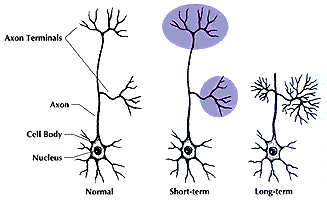 |
Methamphetamine Research
Volume 11, Number 5
November/December 1996 |
Like Methamphetamine, "Ecstasy" May Cause Long-Term Brain Damage
By Robert Mathias, NIDA Notes Staff Writer
Heavy users of ecstasy, a synthetic drug that is structurally similar to
methamphetamine and the hallucinogen mescaline, may be risking brain damage that
remains long after the high has worn off, according to NIDA-supported research.
In a series of studies conducted with rats and nonhuman primates, Dr. George
Ricaurte and his colleagues at Johns Hopkins Medical Institutions first
determined that a single dose of MDMA (3,4-methylenedioxymethamphetamine), only
slightly higher than the size of doses taken by humans, significantly damaged
brain cells called neurons that produce serotonin. Serotonin is a major
neurotransmitter, or chemical messenger, in the brain that is thought to
influence mood, appetite, sleep, and other important functions. Then Dr.
Ricaurte reported that 12 to 18 months after the brains of squirrel monkeys had
been damaged by MDMA, serotonin-producing nerve fibers had regrown abnormally in
some brain regions and failed to regrow at all in others.
Unlike methamphetamine, which damages brain neurons that produce both
serotonin and another important chemical messenger called dopamine, "MDMA
selectively damages serotonin neurons in virtually all species examined to
date," Dr. Ricaurte says.

Dr. Ricaurte's studies have found that MDMA damages
serotonin-producing
neurons in the brains of nonhuman primates. The
illustration on the left shows
a normal neuron. The shaded area in the middle
illustration shows the axon
terminals of the neuron that are damaged by MDMA.
The illustration on the right
shows how, 12 to 18 months after being damaged
by MDMA, serotonin-producing
nerve fibers have regrown excessively in some
areas and not at all in others.
"With MDMA, the doses that people take very closely approach the doses known
to produce neurotoxic effects in animals," Dr. Ricaurte says.
"At this point, the major question is whether the neuronal changes we see in
animals from methamphetamine and MDMA exposure occur in human beings who use
these drugs," he says.
To help answer that question, he is conducting separate clinical studies
using brain imaging techniques to evaluate the possibility of long-term brain
damage in humans who have previously used either methamphetamine or MDMA. These
studies also are assessing the potential functional consequences of such
neuronal damage on aspects of mood, movement, memory, impulse control,
aggression, and sleep cycles.
Determining the functional consequences of MDMA exposure may be more complex
than previously thought, Dr. Ricaurte says. The long-term study with squirrel
monkeys indicated that in some brain areas, such as those containing structures
involved in memory and learning, damaged neurons failed to recover. However, in
other brain areas, specifically those involved in regulating such functions as
sleep and appetite, damaged neurons regrew nerve fiber excessively, resulting in
an overabundance of serotonin being released. "This means that when we evaluate
humans previously exposed to high doses of MDMA, we should be looking for loss
of serotonin function in some brain regions, but perhaps normal or increased
serotonin function in other regions," Dr. Ricaurte says.
Determining the possible damaging effects of ecstasy has become more
important in recent years because the pattern of MDMA use has changed, points
out Dr. Ricaurte. Although ecstasy has been available as a street drug since the
1980s, its use escalated in the 1990s among college students and young adults,
particularly those who participate in all-night dance parties called "raves." In
1995, 2.3 percent of college students said they had used ecstasy at some time
during the year, more than quadruple the 0.5 percent of students who reported
using the drug in 1994, according to NIDA's latest Monitoring the Future study.
The percentage of young adults, ages 19 to 28, who used ecstasy in the past year
also jumped significantly to 1.6 percent in 1995 from 0.7 percent in 1994,
according to the survey.
Source:
Fischer, C.; Hatzidimitriou, G.; Wlos, J.; Katz, J.; and Ricaurte, G.
Reorganization of ascending 5-HT axon projections in animals previously exposed
to recreational drug 3,4-methelenedioxymetham-phetamine (MDMA, "Ecstasy").
Journal of Neuroscience 15:5476-5485, 1995.
From NIDA Notes, November/December, 1996
|














